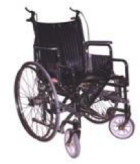Stage 7: Production Planning and Preparation

UpStop Wheelchair Braking System example
Background — Prior Stages
One of the most difficult tasks facing aging manual wheelchair users is the difficulty engaging or keeping engaged the wheel locks on their wheelchairs. Having a stable, non moving, wheelchair during the transfer process is of the utmost importance to all wheelchair users. The UpStop Wheelchair Braking System is designed to reduce the occurrence of falls among manual wheelchair users when they are transferring to and from their wheelchair.
The UpStop automatically engages a set of brakes separate from the wheelchair’s standard wheel locks when the occupant begins to exit, thus preventing the wheelchair from rolling forwards or backwards. When entering the wheelchair, the occupant’s weight is applied to a release arm located just under the wheelchair seat causing the braking system to disengage. This allows the wheelchair to move freely. When the occupant begins to exit the wheelchair, the weight is relieved from the release arm, causing the brake arm to engage. The brake arm provides a frictional force to the wheelchair tire that resists forward and backward motion. There is also a brake release mechanism, that when engaged by an attendant, disengages the braking system allowing an unoccupied wheelchair to be pushed by an attendant or caregiver.
Upon receiving a patented prototype from an inventor, our Initial scope of this project included performing a preliminary market assessment including conducting a consumer panel to verify the need for the device; a preliminary business assessment including searching for competing products and technologies; an initial technical assessment of the inventors prototype; and lastly planning on how to assist in its commercialization. Through Alpha or concept generation focus groups, consumers identified the functions and features of an ideal manual wheelchair braking system. These features were used to create the Beta prototype which was then tested by wheelchair users. Therefore a complete redesign of the inventors prototype was performed prior to introducing the prototype to potential licensing entities.
Stage 7.1
Draft preliminary bill of materials (BOM): A bill of materials must be developed by the organization intending to manufacture a product in order to detail each part and subassembly and the costs associated with them. They will assign part numbers and put an inventory control system into place. As this product was to be licensed to an outside party, the RERC did not generate a fully exploded bill of materials. However, because we were shipping partial assemblies to potential licensing entities for their evaluation, our engineers drafted detailed parts and assembly instructions along with pictures and placement arrows for the various components.
Stage 7.2
Develop materials plan: We provided a materials/component list for the licensing entity. All company part numbers and assembly steps were to be added by the licensing entity.
Stage 7.3
Estimate market needs and costs for production: Previously, in Steps 2.2 (scoping assessments), 4.3 (building business case), and 4.11 (alpha focus groups), we estimated the market size, developed a competing product matrix and defined the true market’s needs by having consumers identify the functions and features needed for their ‘ideal’ automatic manual wheelchair braking system.
Steps 7.4 — 7.11
Develop production and capacity plan through Develop post-launch evaluation plan: Seeing how the UPStop Braking system fit into their production and capacity plans, these activities were the responsibility of the licensing entity.
Steps 7.12
Initiate trial or limited production runs: For the UpStop Wheelchair Braking System, we fabricated a limited production run of 25 units for Sunrise Medical. The UpStop kits, as they were called, were shipped to Sunrise where they were given a Sunrise part number, and added into Sunrise’s inventory control system. These 25 units were to be used as trial or test units for Sunrise’s clients.
Steps 7.13
Test market or trial sell: We determined the product should sell to individuals in manual wheelchairs, institutions, and retail establishments/amusement parks etc. where wheelchairs are provided as a courtesy. Sunrise Medical test marketed the device, but opted not to license. Alimed, the eventual licensee, also test marketed the device at Medtrade, a large medical device show.
Results
As mentioned above, we produced 25 UpStop units for test marketing by Sunrise Medical. To our knowledge, Sunrise made no concerted effort to try and sell these units. In the interim, as there are three primary manual wheelchair manufacturers and distributors in the United States (Sunrise Medical, Invacare, and Drive Medical), we elected to have our fabrication shop develop UpStop kits for all three wheelchair brands.
After we had designed and fabricated UpStop kits that could be used in conjunction with the major manual wheelchair brands, Alimed, a medical device manufacturer and distributor, expressed interest in the concept. Alimed licensed the patent and device and attempted to have their engineering department combine all three UpStop kits (Sunrise Medical, Invacare and Drive Medical) into one universal kit that could be used on all manual wheelchairs. As part of our licensing agreement, the inventor received guaranteed annual minimum payments as well as any additional royalties accrued for each unit sold.
After 2 years, Alimed’s engineering group determined that they were unable to design a suitable universal UpStop kit and terminated the license agreement. As shown by this case example, due to funding constraints, federally funded research and development entities cannot do everything on their own. Many steps in the production process must be undertaken by the licensing manufacturer. For purposes of licensing an invention, work completed in earlier product development stages can be leveraged downstream to justify market need, market size and desired functionality of the product.
